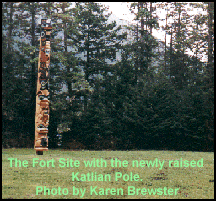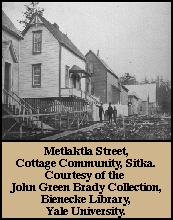 1804 Battle between Tlingit and Russians at the Fort Site
1804 Battle between Tlingit and Russians at the Fort Site
The 1804 Battle of Sitka that took place between the Russians and the local Tlingit Kiks.ádi clan occurred on lands within what is now Sitka National Historical Park. The park was established in 1910 to commemorate this battle and honor the fallen. The Kiks.ádi also have held memorial potlatches at the Fort Site in honor of their ancestors who died in the battle. The Katlian Pole located at the Fort Site was raised specifically to honor and remember this key piece of their history.
Go to Fred Hope's interview to hear him talk about the battle and commemorative survival march.
Go to Louise Brady's, Mark Jacobs Jr.'s, and George Hall's interviews to hear them talk about the battle.
Go to Louise Brady's, Irene Jimmy's and Ellen Hope Hays' interviews to hear them talk about memorial potlatches.
 Resource Use
Resource Use
The Tlingit clans (Kaagwaantaan, Kiks.ádi, and Coho) lived along the Indian River before the Russians came. This area is now part of Sitka National Historical Park. They made a living by hunting, fishing, and plant gathering in the area, a tradition that has continued through the generations, even up to the present day. In 1995, local Sitka carvers created a multi-clan pole to commemorate the history of the Indian River. The pole's Tlingit name, Haa leelk'u has Kaastaheendax, means "honoring our ancestors who lived along Indian River."
Go to Irene Jimmy's, Fred Hope's, Al Perkins', Mark Jacobs Jr.'s, Ellen Hope Hays', Gil Truitt's and George Hall's interviews to hear them talk about Tlingit hunting, fishing and plant gathering.
Cott age Community -- History and Importance
age Community -- History and Importance
The Cottage Community was a small residential community established around 1888 by Sheldon Jackson Mission/School for its graduates. It was a place for the newly educated and Christianized Tlingit to maintain their new lifestyle. Residents agreed to keep the Sabbath, provide education for their children, maintain public health, abstain from alcohol and gambling, and avoid traditional festivities and customs. The Cottages developed into a cohesive community, which produced many of Sitka's modern day Tlingit leaders. The Cottages was located between Sheldon Jackson School and the Park, so Cottage residents had a close involvement with the Park. They used it for recreation and enjoyment, continued their traditional uses of it, and benefited from tourist related business opportunities there. It was even a backyard for their children to play in. Click here for more about the Cottages.
Go to Ellen Hope Hays' and Gil Truitt's interviews to hear them talk about the Cottage Community.

